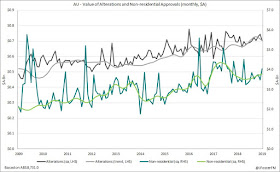Building Approvals — April | By the numbers
- Total dwelling approvals (including the private and public sectors) fell by 4.7% in April to 14,123 (seasonally adjusted) with the market forecasting a flat (0.0%) outcome. Approvals fell by 13.4% in March revised from -15.5% in this release.
- Over the year, dwelling approvals are down by 24.2% (prior rev: -25.4%)
- Unit approvals fell by 7.2% (prior rev: -24.5%) in the month to 5,672 to be down by 27.8% through the year (prior rev: 33.8%)
- Approvals for houses fell by 2.9% (prior rev: -3.3%) to 8,452 with the annual decline extending to -21.5% (prior rev -18.1%)
- The trend series detail showed total dwelling approvals down by 0.6% in April and by 21.8% through the year. Unit approvals lifted by 1.3% month-to-month but are -27.5%Y/Y. House approvals declined by 1.9% in April to -17.1%Y/Y.
The available detail, which is not seasonally adjusted, indicated that the weakness in April was broad based. House approvals continued to weaken, while for units there was a sharp contraction from the low-rise category and a more modest fall from the high-rise segment. The chart, below, highlights the deteriorating trend for all dwelling types.
Dwelling approvals fell in most states in April, though New South Wales (+4.8%) and Queensland (+11.3%) both recorded increases. However, approvals have fallen sharply year-on-year in all states with the exception of Tasmania (+2.9%). The full breakdown is shown, below.
The value of alteration work approved to be done on residential properties fell by 5.4% in April to $703.5m but remains modestly up on a year earlier (+1.4%). The value of non-residential work approved is volatile month-to-month and this was the case in April with a 16.1% rise to $4.05bn (+19.3%Y/Y).
Building Approvals — April | Insights
April's report was another weak update, with dwelling approvals continuing to slide across the categories. It will be interesting to watch this series over the coming months given recent developments including; the clear signal from the Reserve Bank of Australia that they are prepared to cut interest rates, the removal of uncertainty around the impact of proposed changes to capital gains tax and negative gearing following the outcome of the federal election and the proposal by banking regulator APRA to ease its serviceability assessment criteria.





